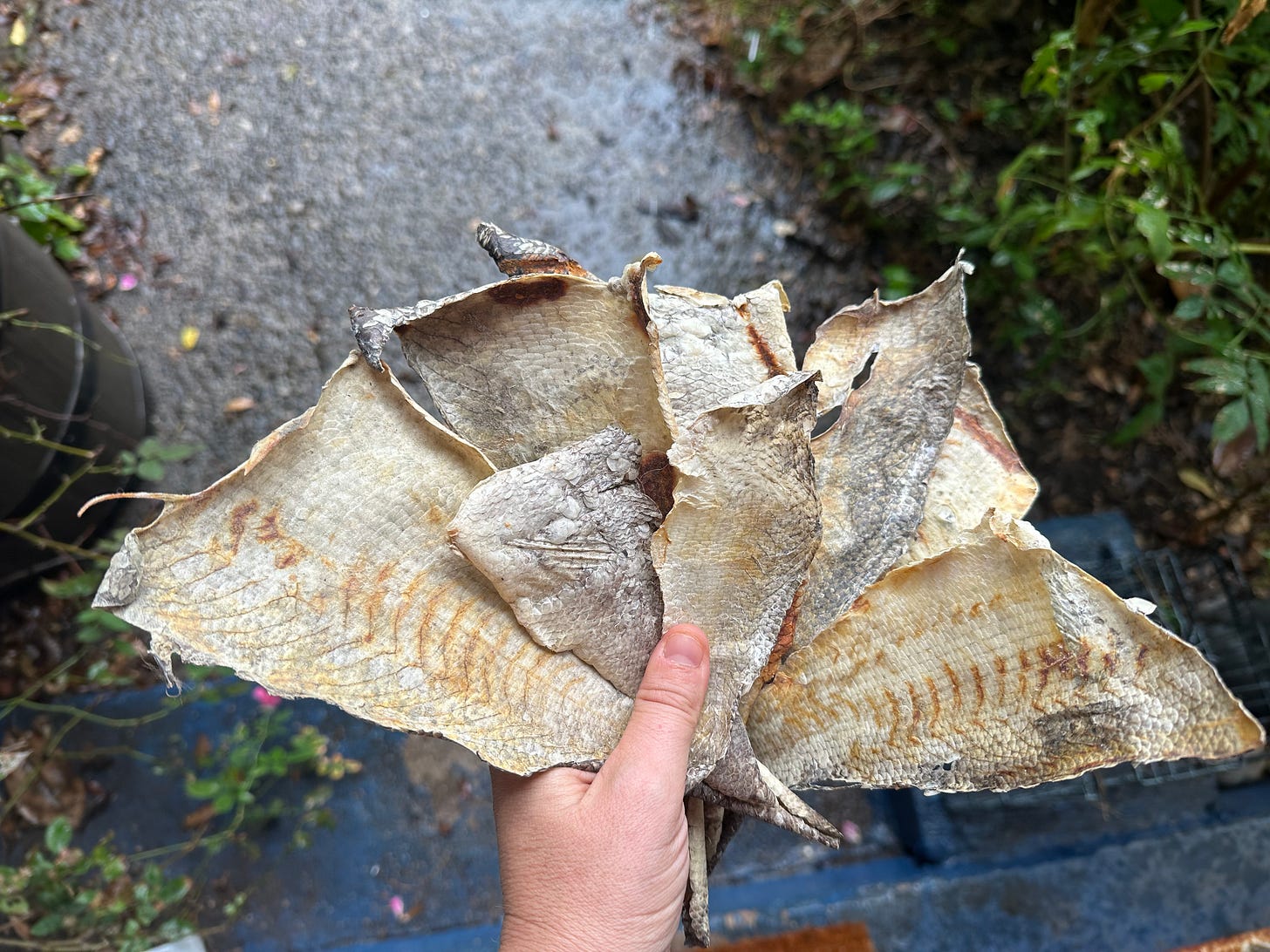When life hands you fish skins, make art
The long-awaited fish skin parchment tutorial (plus ASMR video)
Making parchment out of fish skin
If you like this, consider becoming a paid subscriber (on Substack, Patreon, or here, through my website, if you don’t want to pay either of those companies).
Paid subscribers get recipes, behind the scenes looks at my books, free online classes, and more. With more good stuff on the way in 2025!
A handful of years ago, I learned how to make fish parchment. My friend Doc taught me how to filet and skin fish (I'm still no expert), and in this case, we used bass my friend Ben had caught out in North Florida. A few steps later, I had fish parchment.
Fish skins have been used in clothing in art in indigenous Alaskan communities for generations, and there are also records of fish skins being repurposed in this way in Germany.
Fish parchment is surprisingly durable and long-lasting: Those pieces of parchment I made almost a decade ago are still in as good a condition today as they were when Doc and I cured them.

I'd always wanted to revisit that experiment for fun, and in testing my fish recipes for The Essential Preserving Handbook, I found myself with an abundance of fish skins. Yes, I could make crispy fish skins to garnish things, or feed them to my cats, or whatever else.
Or, I could indulge my dual loves of book history and food history, and turn those fish skins into unique, beautiful writing surfaces.
Here's how I did it:
The first time I made parchment, and this time too, my first port of call was Verheyen's article on the history of fish skin leather and parchment in Germany (with instructions for making your own).
This is a relatively quick process, as curing and drying skins goes, and because fish skins from store-bought fish tend to be small, you don't need a ton of space to do it. You can use the skins off scaled, but skin-on, filets purchased from the store. Or use skins from fish you caught: Bearing in mind that skin from the filets works best here, as the fins result in holes in the final product.
Start by gently skinning the filet, then reserving the meat to cook later.
Take your skins and soak in undyed detergent (I use Dr. Bronner's dish soap, which I buy by the gallon jug, but any undyed detergent will do).
Let it soak for an hour or so, then rinse and repeat until the skin is no longer oily and any remaining flesh left on it has softened.
Using a metal spatula or (my preference) the back of a knife, gently scrape the inside of the skin to remove any remaining flesh.
When I used to make this, I would hang my fish parchment along my clothesline, which worked ok for larger pieces that I could securely attach, but could result in curling in smaller ones.
Now, I spread my parchment out on a box and hold it in place with push pins:
To do this, start by gently patting your fish skin dry with lintless cloths or paper towels.
Then, take a cardboard box that you are not emotionally attached to (and that doesn't have any printing or dyes that could transfer to the fish), and carefully stretch your skin out flat, securing in place with push pins.
Place in direct sunlight until dried: This can take a few hours depending on heat, humidity, etc.
Fish parchment can be used like other animal parchments for writing and/or for book binding.
Optional, but recommended bonus step: Make an ASMR video out of your fish parchment, like I did (and if you do, please share it with me!)

Here are some extra resources on fish skin parchment in clothing and art:
Here are some traditional uses, fish skin in Alaska native cultures, artist Joel Isaak and fish skin, and a piece on salmon skin coats.
And a few pieces on process: Here, and here, and a video on artist Joel Isaak. And this piece, on tanning trout skins in green tea.
If you make your own fish parchment (and/or make art out of it), I'd love to see it! Let me know in the comments.





